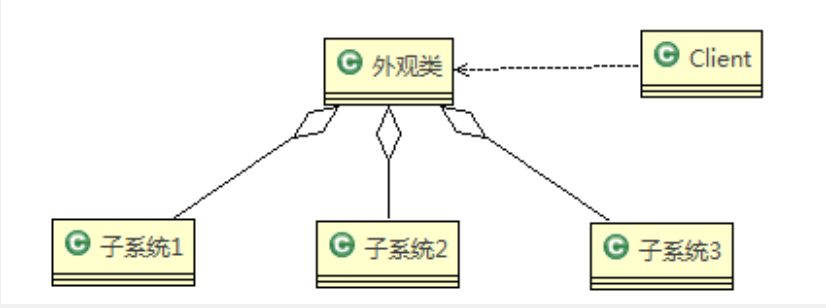介绍
- 外观模式(Facade),也叫“过程模式:外观模式为子系统中的一组接口提供一个一致的界面(java中的各个方法),此模式定义了一个高层接口,这个接口使得这一子系统更加容易使用
- 外观模式通过定义一个一致的接口,用以屏蔽内部子系统的细节,使得调用端只需跟这个接口发生调用,而无需关心这个子系统的内部细节
原理
原理类图的说明(外观模式的角色)
- 外观类(Facade): 为调用端提供统一的调用接口, 外观类知道哪些子系统负责处理请求,从而将调用端的请求代理给适当子系统对象
- 调用者(Client): 外观接口的调用者
- 子系统的集合:指模块或者子系统,处理Facade 对象指派的任务,他是功能的实际提供者
案例
组建一个家庭影院:
DVD播放器、投影仪、自动屏幕、环绕立体声、爆米花机,要求完成使用家庭影院的功能,其过程为:
• 直接用遥控器:统筹各设备开关
• 开爆米花机
• 放下屏幕
• 开投影仪
• 开音响
• 开DVD,选dvd
• 去拿爆米花
• 调暗灯光
• 播放
• 观影结束后,关闭各种设备
//各种设备public class DVDPlayer {private static DVDPlayer instance = new DVDPlayer();public static DVDPlayer getInstanc() {return instance;}public void on() {System.out.println(" dvd on ");}public void off() {System.out.println(" dvd off ");}public void play() {System.out.println(" dvd is playing ");}//....public void pause() {System.out.println(" dvd pause ..");}}public class Popcorn {private static Popcorn instance = new Popcorn();public static Popcorn getInstance() {return instance;}public void on() {System.out.println(" popcorn on ");}public void off() {System.out.println(" popcorn ff ");}public void pop() {System.out.println(" popcorn is poping ");}}public class Projector {private static Projector instance = new Projector();public static Projector getInstance() {return instance;}public void on() {System.out.println(" Projector on ");}public void off() {System.out.println(" Projector ff ");}public void focus() {System.out.println(" Projector is Projector ");}//...}public class Screen {private static Screen instance = new Screen();public static Screen getInstance() {return instance;}public void up() {System.out.println(" Screen up ");}public void down() {System.out.println(" Screen down ");}}public class Stereo {private static Stereo instance = new Stereo();public static Stereo getInstance() {return instance;}public void on() {System.out.println(" Stereo on ");}public void off() {System.out.println(" Screen off ");}public void up() {System.out.println(" Screen up.. ");}}public class TheaterLight {private static TheaterLight instance = new TheaterLight();public static TheaterLight getInstance() {return instance;}public void on() {System.out.println(" TheaterLight on ");}public void off() {System.out.println(" TheaterLight off ");}public void dim() {System.out.println(" TheaterLight dim.. ");}public void bright() {System.out.println(" TheaterLight bright.. ");}}
//外观类(面向调用者的类)public class HomeTheaterFacade {//定义各个子系统对象private TheaterLight theaterLight;private Popcorn popcorn;private Stereo stereo;private Projector projector;private Screen screen;private DVDPlayer dVDPlayer;//构造器public HomeTheaterFacade() {super();this.theaterLight = TheaterLight.getInstance();this.popcorn = Popcorn.getInstance();this.stereo = Stereo.getInstance();this.projector = Projector.getInstance();this.screen = Screen.getInstance();this.dVDPlayer = DVDPlayer.getInstanc();}//操作分成 4 步public void ready() {popcorn.on();popcorn.pop();screen.down();projector.on();stereo.on();dVDPlayer.on();theaterLight.dim();}public void play() {dVDPlayer.play();}public void pause() {dVDPlayer.pause();}public void end() {popcorn.off();theaterLight.bright();screen.up();projector.off();stereo.off();dVDPlayer.off();}}
//用户只调用外观类就可以控制家庭影院的所有设备public class Client {public static void main(String[] args) {//这里直接调用。。 很麻烦HomeTheaterFacade homeTheaterFacade = new HomeTheaterFacade();homeTheaterFacade.ready();homeTheaterFacade.play();homeTheaterFacade.end();}}
外观模式的注意事项和细节
- 外观模式对外屏蔽了子系统的细节,因此外观模式降低了客户端对子系统使用的复杂性
- 外观模式对客户端与子系统的耦合关系,让子系统内部的模块更易维护和扩展
- 通过合理的使用外观模式,可以帮我们更好的划分访问的层次
- 当系统需要进行分层设计时,可以考虑使用Facade模式
- 在维护一个遗留的大型系统时,可能这个系统已经变得非常难以维护和扩展,此时可以考虑为新系统开发一个Facade类,来提供遗留系统的比较清晰简单的接口, 让新系统与Facade类交互,提高复用性
- 不能过多的或者不合理的使用外观模式,使用外观模式好,还是直接调用模块好。要以让系统有层次,利于维护为目的。

